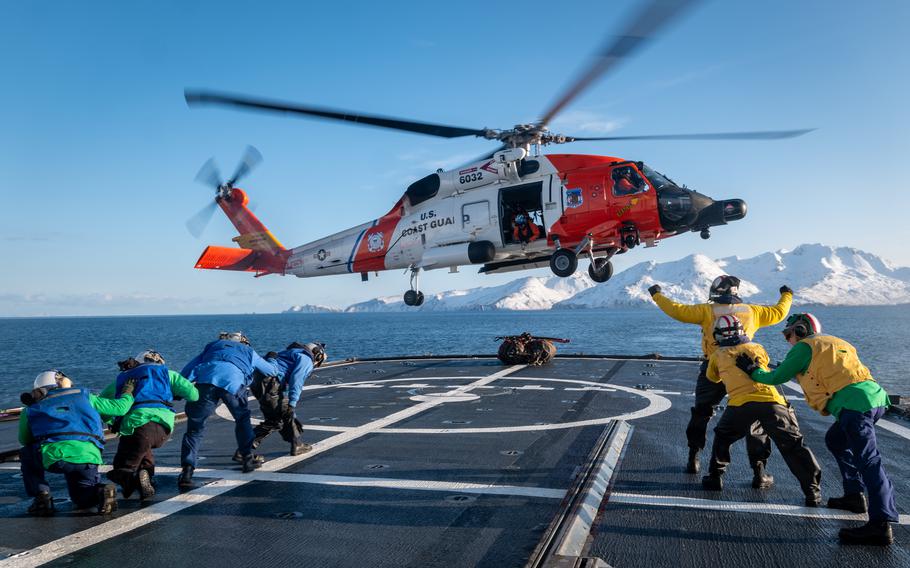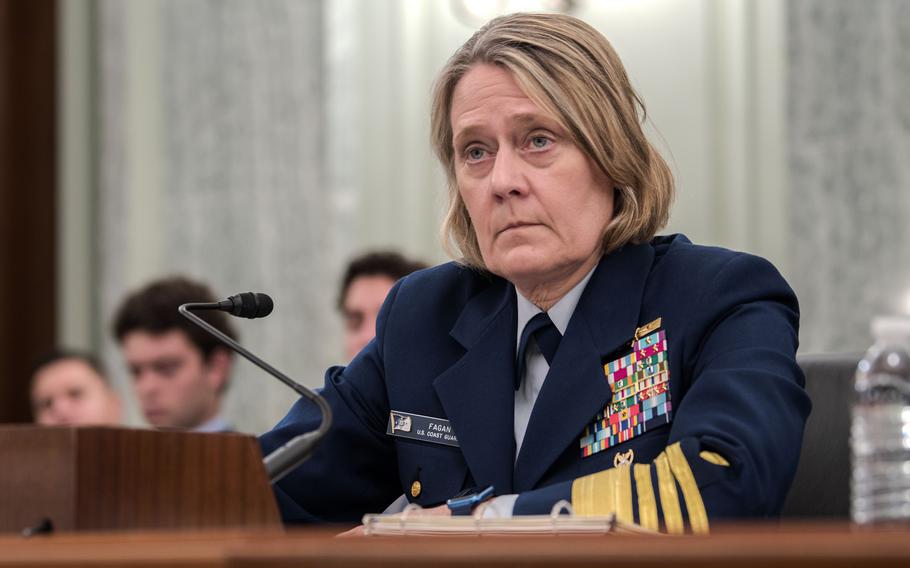
Crew members from Coast Guard Cutter Alex Haley conduct helicopter operations with a Coast Guard Air Station Kodiak MH-60 Jayhawk helicopter aircrew in the Bering Sea on Jan. 8, 2024. (U.S. Coast Guard )
The admiral leading the Coast Guard told a congressional budget panel Wednesday that the service is ready for a larger role in national defense but will need the funds to do the job.
“Demand for Coast Guard missions has never been higher and we must continue to adapt to an evolving global security environment,” Adm. Linda Fagan, the service’s commandant, testified to the homeland security subpanel of the House Appropriations Committee.
The Coast Guard’s budget request for fiscal 2025 is $13.8 billion, slightly down from $13.9 billion in 2024. Service officials have said the requested amount is primarily to meet the congressionally mandated goal of a 1% budget reduction in most federal budgets.
The proposed Defense Department budget is slightly less than $900 billion.
The Coast Guard has about 50,000 active-duty and auxiliary personnel who operate 259 cutters, 143 helicopters, 157 fixed-wing aircraft, and more than 1,600 smaller boats and launches, according to the service website.
The expanding worldwide role of the Coast Guard includes helping challenge Chinese shipping, patrol the Arctic region, lead anti-terrorist port safety, and train foreign partners in drug and illegal shipping interdiction. These efforts are all in addition to maintaining its traditional roles of water emergency rescues, inspecting ship safety, and enforcing environmental regulations on waterways.
Fagan said the Coast Guard has been able to plan for fewer months than in 2024, but a combination of increased roles in Asia and the Arctic, keeping pace on planned cutter purchases, and the age of much of the existing service fleet will undercut the basic upkeep of what the Coast Guard already has.
“Our maintenance budget does not cover our planned asset maintenance projects next year,” she said. “The service needs increased and reliable funding for many high priority acquisition programs to ensure the service can sustain ships, aircraft and shore infrastructure.”
Despite its relatively small size, the Coast Guard has been part of the Pentagon’s plan to increase American maritime presence in the Indo-Pacific region.
The Coast Guard has increased its patrols in the western Pacific and is training partner nations on how to interdict commercial vessels carrying illegal cargo, including the synthetic opiate fentanyl, which has created a spike in addiction and drug-related crime in the United States.
An expansion of Coast Guard facilities and personnel in the Seattle area is partly to address increased Chinese military and commercial shipping in the Arctic region.
The service is looking at eventually increasing the number of icebreakers in the region. The United States now has one operational icebreaker available. Russia has about 40 military and commercial ships.

Coast Guard Commandant Adm. Linda Fagan testifies before the Senate Commerce, Science, and Transportation Committee during a hearing in July 2023 on Capitol Hill in Washington, D.C. (Carlos Bongioanni/Stars and Stripes)
Fagan called building icebreakers a “top priority” as Russia and China expanded operations in the Arctic. Icebreakers will allow the United States to stay and operate in more areas longer.
“Actual presence is required to ensure our own national security and sovereignty in the Arctic,” she said.
To pay for the increased operational tempo, the Coast Guard has stretched the procurement of two offshore patrol cutters, while the last of 11 national security cutters is nearing completion. This enables the Coast Guard to cut its spending for the ships from $73 million in 2024 to a request of $13 million in 2025.
The savings can double the allocation for the purchase of smaller cutters, barges, tenders, and shallow-water craft used in inland waterways to $135 million in the 2025 proposal.
Fagan said funds would also be used to modernize existing equipment, including the shift to the MH-60T Jayhawk helicopter from the MH-65 Dolphin, some of which have been in service since the 1980s.
Questions from subcommittee members ranged from geopolitical to societal to parochial.
Rep. Henry Cuellar, D-Texas, the top Democrat on the committee, praised the Coast Guard’s presence alongside the Navy to counter Chinese expansion in the Indo-Pacific.
“For example, in the Taiwan Strait in the South China Sea and your work with the Philippine Coast Guard are important steps to make sure that we sent out the strong message,” he said.
Lawmakers also asked the admiral about service plans to fix the sexual harassment, abuse and assault issues at the Coast Guard Academy. Problems at the New London, Conn., school surfaced when an internal report titled “Fouled Anchor” was leaked to the media. The report focused on the failure of senior officers to pursue discipline or charges against perpetrators identified by victims.
“We will continue to work together to strengthen a workplace climate aligned with our core values,” Fagan said.
But the admiral said her goal was to extend significant reforms throughout the service, not just at the training ground for future officers.
“What’s different today? Why is this different from other times that we’ve been held accountable as an organization for failing about sexual assault, harassment, bullying, retaliation, or retribution?” Fagan asked. “What’s different this time is an acknowledgment that these behaviors are not appropriate in our service, and we’re going to move to eradicate them. This is not a checklist thing.”
Other lawmakers asked about using waterway patrols to reduce the number of undocumented migrants crossing into the United States via coastal routes through the Pacific, Atlantic and Caribbean.
“We remain engaged and in position to counter anyone attempting those illegal and perilous attempts to reach our shores,” Fagan said.
She said using uncrewed catamaran-like sail drones with sensors and cameras can tip off Coast Guard cutters when a group departs on a water route to the United States.
“This is lifesaving work,” Fagan said. “When people take to sea in unseaworthy conveyances, the risk of loss of life is substantial.”
While the hearing dealt with geopolitical hot spots, drones, drugs, emergencies at sea, and other wide-scope issues, it was also a chance for committee lawmakers to ask questions about the Coast Guard’s priorities in their districts.
Rep. Ashley Hinson, R-Iowa, asked where the service’s wish list ranked a new ship to replace the USCGC Wyaconda, a nearly 60-year-old cutter based in Dubuque on the Mississippi River.
Fagan called the Wyaconda “an icon” that needed to be replaced.
The admiral said the Wyaconda was not in the first round of service requests for new ships.
But Fagan said she plans on retiring the venerable cutter at some point.
“It will be replaced,” she said.